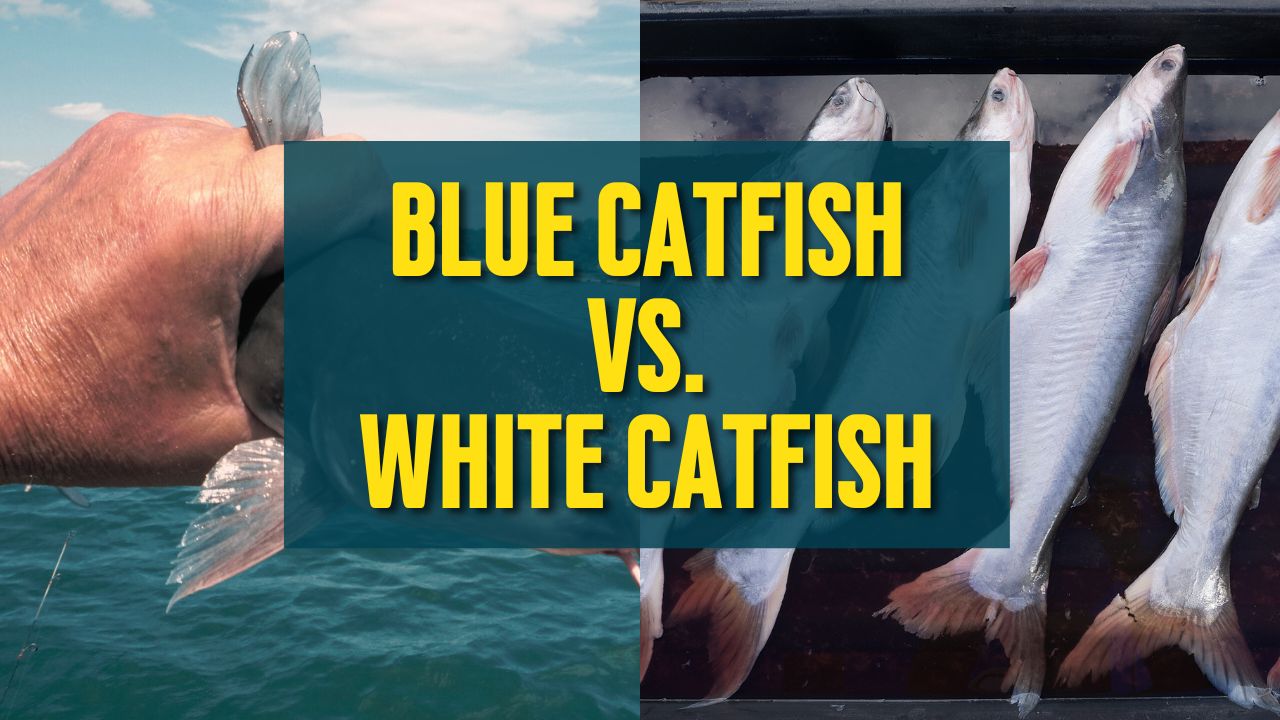In the world of catfish, the blue catfish and white catfish stand out as distinctive species with unique characteristics and angling appeal. This in-depth article aims to provide a comprehensive comparison between these two fascinating aquatic creatures, covering their physical attributes, habitat preferences, behaviors, identification methods, and more. Join us on a journey to explore the world of blue catfish and white catfish, and uncover the secrets that make them captivating targets for anglers.

Blue Catfish: Characteristics and Identification
The blue catfish (Ictalurus furcatus) boasts a striking appearance with its slate-blue to grayish coloration. This mottled pattern on its dorsal side sets it apart from other catfish species. One of its defining features is the deeply forked tail, which assists in its movement through the water. Additionally, the blue catfish’s head is notably flattened, giving it a unique profile. Some blue catfish individuals can exceed 100 pounds in weight, making them one of the largest freshwater fish in North America.
White Catfish: Characteristics and Identification
In contrast, the white catfish (Ameiurus catus) possesses a more subdued appearance. Its olive to brownish-gray hue is accompanied by a light underbelly, differentiating it from its blue counterpart. The white catfish lacks the distinctive forked tail of the blue catfish, displaying a rounded tail shape instead. While generally smaller, with most adults ranging from 2 to 4 pounds, the white catfish is renowned for its tenacity and spirited fight when hooked.
Habitat and Distribution
Blue catfish thrive in various water bodies, including large river systems, reservoirs, and lakes. Their adaptability to slow-moving and deep waters makes them versatile inhabitants of different aquatic environments. Originally native to the Mississippi River basin, blue catfish have been introduced to water bodies across the United States, demonstrating their ability to adapt to diverse habitats.
The white catfish prefers freshwater environments such as ponds, lakes, and slow-moving rivers. It is commonly found along the Atlantic seaboard of the United States. The white catfish’s adaptability to various water conditions contributes to its wide distribution.
Behavior and Feeding Habits
Blue catfish are apex predators with a carnivorous appetite. Their opportunistic feeding habits revolve around preying on other fish species. As top predators, blue catfish play a vital role in regulating fish populations within aquatic ecosystems.
Conversely, white catfish exhibit a more varied diet that includes aquatic insects, crustaceans, and small fish. Their omnivorous behavior contributes to nutrient cycling within their habitats. The white catfish’s scavenging and bottom-feeding tendencies further enhance their ecological importance.
Ecological Impact and Management
The introduction of blue catfish to non-native waters raises ecological concerns due to their potential to disrupt local ecosystems and outcompete native species. Their predatory nature and rapid growth can lead to shifts in aquatic community dynamics. Consequently, management strategies, including regulations and conservation efforts, have been implemented to control their impact in various regions.
White catfish, while possessing a more limited distribution, have the potential to disrupt local balances if introduced to non-native waters. However, the extent of their impact may vary.
Angling Appeal and Culinary Attributes
Blue catfish are highly sought after by anglers due to their size, strength, and exhilarating fights. Pursuing trophy-sized blue catfish presents a thrilling challenge that tests the skills and equipment of sport fishermen. Additionally, blue catfish meat is considered high-quality, boasting a mild flavor that lends itself well to various culinary preparations.
White catfish may be smaller, but they offer a rewarding angling experience nonetheless. Their vigorous fighting spirit and eagerness to take bait make them a popular choice among recreational anglers. The white catfish’s meat is equally prized for its taste and texture, making it a staple in regional cuisines.
Identification Comparison
Blue Catfish
- Coloration: Slate-blue with mottled appearance
- Tail Shape: Deeply forked
- Size and Weight: Up to 100+ pounds
- Identification Techniques: Forked tail, flattened head
White Catfish
- Coloration: Olive-gray
- Tail Shape: Rounded
- Size and Weight: 2 to 4 pounds
- Identification Techniques: Rounded tail, smaller size
Habitat and Distribution Comparison
Blue Catfish
- Preferred Habitats: Large rivers, reservoirs, lakes
- Native Range: Mississippi River basin and introduced
- Habitat Adaptability: Adaptable to slow-moving and deep waters
White Catfish
- Preferred Habitats: Ponds, lakes, slow-moving rivers
- Native Range: Eastern United States, Atlantic seaboard
- Habitat Adaptability: Versatile in freshwater environments
Feeding Habits Comparison
Blue Catfish
- Feeding Behavior: Apex predator, carnivorous
- Diet Preferences: Primarily preys on fish species
White Catfish
- Feeding Behavior: Omnivorous, scavenger
- Diet Preferences: Eats aquatic insects, crustaceans
Comparison Table: Blue Catfish vs. white Catfish
| Aspect | Blue Catfish | White Catfish |
|---|---|---|
| Identification | Slate-blue color, forked tail | Olive-gray color, rounded tail |
| Size and Weight | Up to 100+ pounds | 2 to 4 pounds |
| Habitat Preference | Large rivers, deep waters | Ponds, slow-moving rivers |
| Behavior | Apex predator, carnivorous | Omnivorous, scavenger |
| Angling Appeal | Thrilling fights, prized meat | Spirited fight, popular target |
| Culinary Excellence | Mild-flavored meat, culinary versatility | Prized taste and texture |
Final thoughts:
In the fascinating world of catfish, the blue catfish and white catfish emerge as distinct entities, each contributing to the intricacies of aquatic ecosystems and angling experiences. While the blue catfish commands attention with its size and predatory prowess, the white catfish captivates with its spirited fight and culinary appeal. Understanding their differences enhances our appreciation for the diversity of aquatic life and the thrill of angling.
